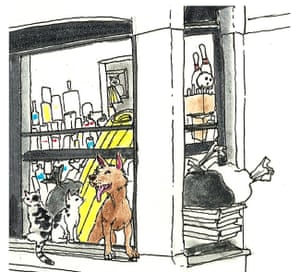If my street was picture-book worthy, the house itself was not. I lived in a pre-war building and it chilled me to consider that when it was built, my ancestors were chattel slaves. The facade was crumbling, the iron fence was falling apart. When glass had broken on the front parlor windows, my landlady had replaced them with cheap plastic.
But the house was near many subway lines, the most cutting-edge arts venues, and the best dining in the greatest city on the face of the Earth. For all of this, I paid just $1,000 a month for some 2,400 square feet across two upper floors – the kind of bargain which is the stuff of New York legend.
To get the apartment, I made a two-part devil’s bargain.
First, I had to accept that my landlord was a compulsive hoarder who didn’t want to get rid of things that were trash, if not Level 4 biohazards. She held on to everything as if her life depended on it (and psychologically, it did). And second, I would have to take care of her animals when she went out of town a few weeks each summer. She had a mangy mutt named Timmy*, nearly blind with cataracts and six cats (one had a leg missing, and another only had one eye).
Honestly, I thought I could manage the situation. And regardless, my apartment was going to be so big and so clean. I’d have nine rooms and two bathrooms all to myself. I could fill it with tasteful second-hand mid-century furniture. I could have a full-sized Christmas tree each winter and I could have a boyfriend and cook with him. I could even put up friends and family in one of the guest rooms (that’s guest rooms, plural).
Besides, living upstairs from a hoarder wasn’t so unusual. According to a 2013 article in Scientific American, “Between five million and 14 million people in the US are compulsive hoarders.” Hoarding seems like a logical symptom to appear in a world sick from consumer capitalism, after all. I could deal with it.
I was wrong.
•••
I had met my landlady through friends of friends from my hometown. She was a white woman who had become a Sai Baba Hindu in the 1970s and had an inappropriate sense of her connection to Indian culture. She was older and looking for a tenant who’d shovel her walk when it snowed and help out here and there.
I knew she was kooky, but the first sign that something was seriously wrong didn’t come until I called her when she wasn’t home and her outgoing message breathlessly referred to her blind dog:
“Thank you for calling Timmy Enterprises. We are not in right now, please leave a message for Timmy after the beep.”That alone should have tipped me off. She also had pictures of her dog all over her house and referred to him as “my soulmate”.

Sometimes, there was a feline carcass to contend with.
“I think Muffy* has died,” she said one morning through sobs. I wasn’t quite sure how she could not know if her cat was dead or alive, but it turns out she had thrown a blanket over the poor dying animal. “I was worried she might die during the night, and I can’t bear to look at anything dead!”
She then left the room and yelled, “OK, can you see if she’s dead and if so, put her in a bag so we can bury her in the backyard?”








0 comments:
Post a Comment
Thanks for your comment.
Note: Only a member of this blog may post a comment.